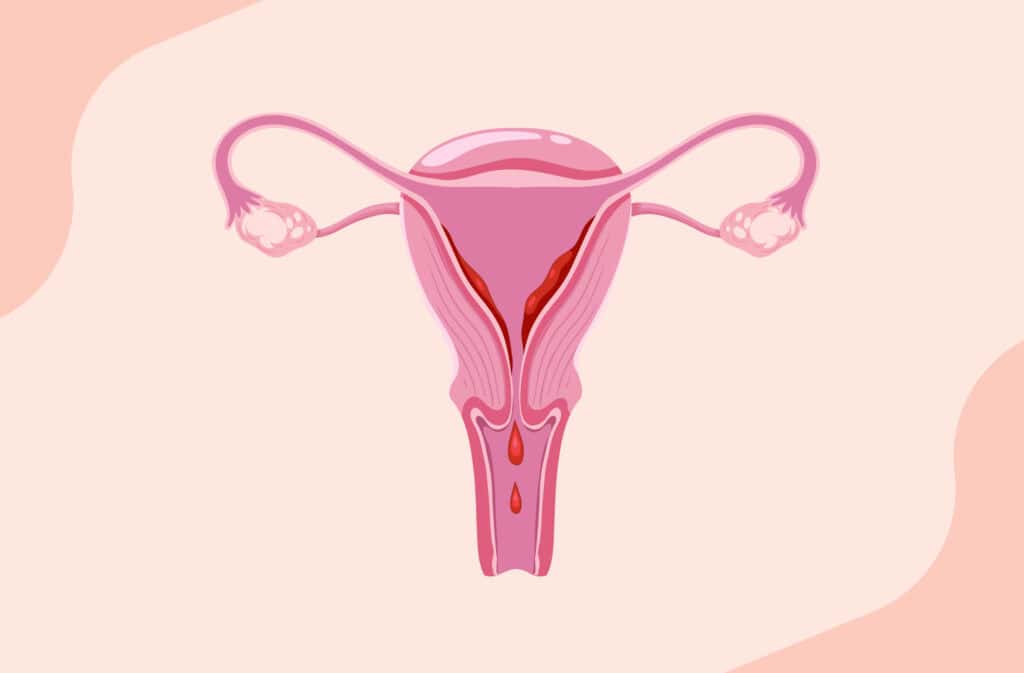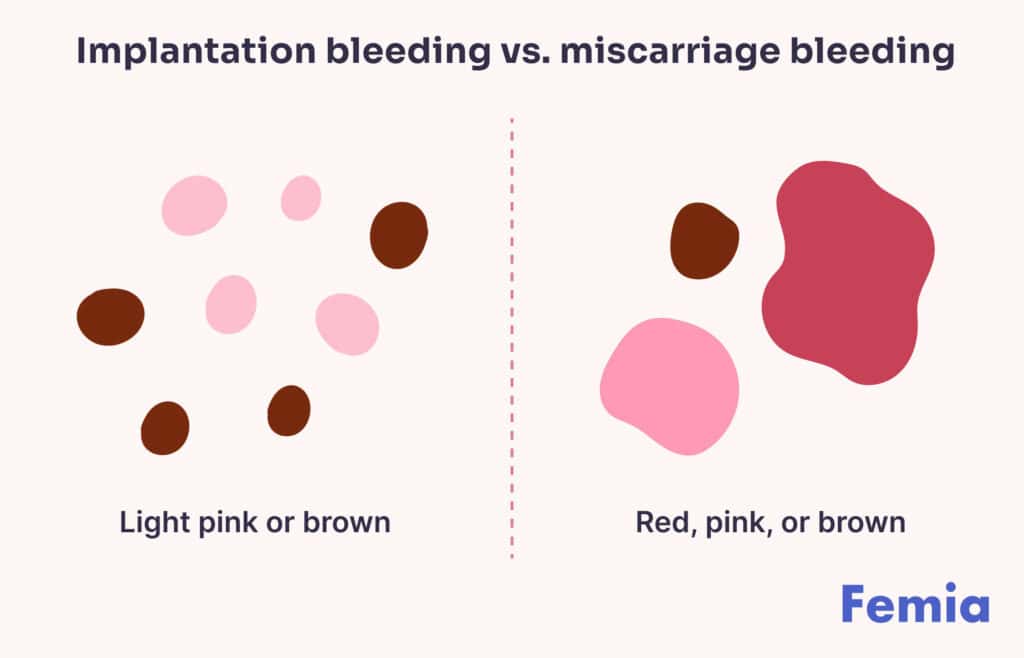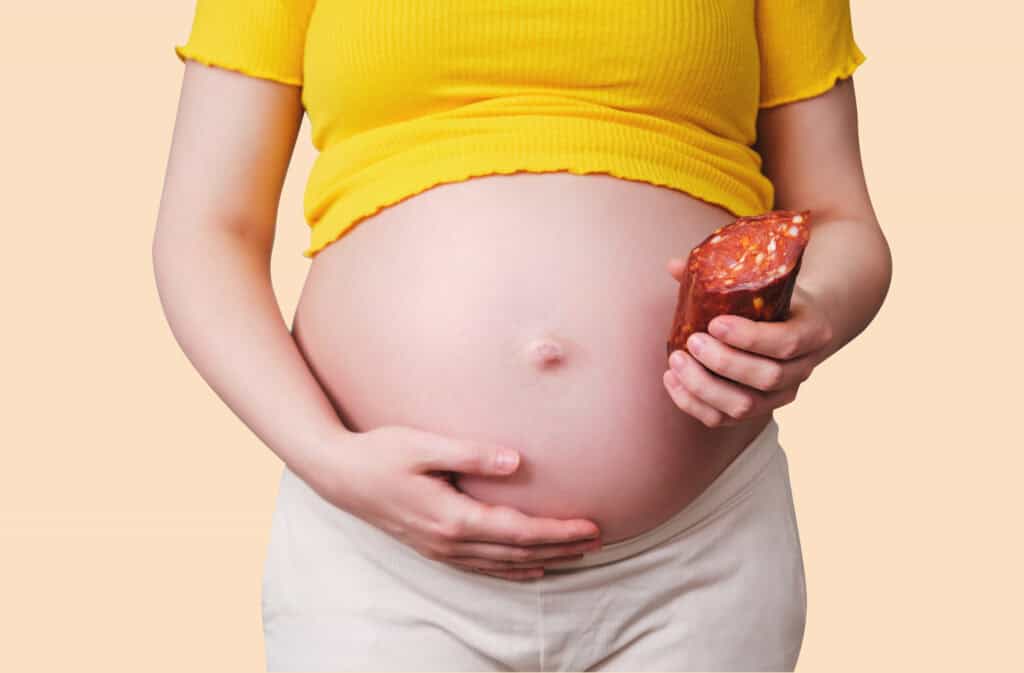Femia > Health Library > Pregnancy > Pregnancy health > Implantation bleeding vs. miscarriage: Key differences explained
Implantation bleeding vs. miscarriage: Key differences explained

- Updated Feb 10, 2025
- Published
CRAFTED BY HUMAN
Crafted by human At Femia, we provide accurate and up-to-date information at every stage of your journey, from trying to conceive, pregnancy and postnatal support. All content is created by a real person based on in-depth research and own professional experience. Femia ensures that you will receive expert advice, strict accuracy and a personalized approach from our authors/medical experts. Learn more about our editorial policy.
FACT CHECKED
Fact checked At Femia Health, we maintain the highest standards of editorial excellence in delivering content focused on helping you conceive, guiding you through pregnancy, and supporting you postpartum. Explore our content review principles to learn how we ensure the accuracy and quality of our health and lifestyle tips for every stage of your journey.

Created with Hector Chapa, MD, FACOG, Clinical associate professor, Obstetrics and Gynecology Texas A&M University, College of Medicine in Bryan-College Station, USA
Implantation bleeding vs. miscarriage:
- Timing: Implantation occurs 7-10 days after conception; miscarriage can happen anytime in early pregnancy.
- Color: Implantation is light pink/brown spotting; miscarriage starts light but becomes heavy, red bleeding with clots.
- Duration: Implantation lasts 1-3 days; miscarriage can continue for weeks.
- Symptoms: Implantation may have mild cramps; miscarriage often involves severe cramping and back pain.
- Tissue: Miscarriage may pass grayish tissue; implantation doesn’t.
What are the key ways to recognize implantation bleeding vs. miscarriage? Both types of bleeding may happen during early pregnancy, and it’s normal to feel confused or anxious about them. But, don’t worry! There are some basic differences between implantation bleeding and miscarriage. In this article, we’ll help you learn to identify them, as well as when to consult your healthcare provider.
Femia helps millions of women understand
pregnancy symptoms and potential risks
What is implantation bleeding?
Implantation bleeding is an early sign of pregnancy that occurs when a fertilized egg attaches to your uterine lining to start developing into a fetus. It typically occurs 7–10 days after fertilization and appears as light bleeding or spotting. Implantation bleeding can last for several hours to a few days.
Implantation bleeding is often mistaken as an early period, but early periods are heavier and occur for a longer duration than implantation bleeding.
👉Find out more: Your pregnancy checklist: Week-by-week guide to preparing for baby
What is a miscarriage?
“Miscarriage” is defined as the death of a fetus in a mother’s womb. It is also known as “loss of pregnancy.” Miscarriage commonly occurs in the first trimester, or the first three months, of pregnancy.
It typically starts as light bleeding, slight brownish discharge, or spotting that eventually progresses to heavy bleeding with large blood clots. It is often accompanied by cramping and back pain.
👉Find out more: Pregnancy after miscarriage: Fertility, timing, and emotional recovery
Implantation bleeding vs. miscarriage: Key differences

| Features | Implantation bleeding | Miscarriage bleeding |
|---|---|---|
| Color | Light pink or brown. | Red, pink, or brown. |
| Amount | Mild, light bleeding or spotting. | Starts as light spotting and turns into heavy bleeding with blood clots. |
| Timings | 10–14 days after fertilization. | Anytime during the first trimester of pregnancy. |
| Symptoms | Breast tenderness, mood swings, frequent urination, nausea, fatigue, light cramps, or backaches. | Pain in the lower back or abdominal cramping, passage of blood clots, tissue, or fluid from the vagina. |
| Duration | 1–3 days. | 4–6 weeks. |
👉Find out more: How long after implantation bleeding can I test for pregnancy?
Blood clots vs. miscarriage tissue
Miscarriage tissue is the material of the placenta, amniotic sac, and dead fetus that comes out of your vagina after a miscarriage. It appears as a small white or grayish mass.
On the other hand, blood clots are darker and redder than miscarriage tissue. Blood clots can appear during heavy menstrual bleeding, but can also come out with miscarriage tissue as a result of bleeding from a miscarriage. This is the most definitive indicator of pregnancy loss.
Here are some of the key differences between blood clots and miscarriage tissue:
| Features | Blood clots | Miscarriage tissue |
|---|---|---|
| Appearance | Thick, jelly-like texture. | More solid, soft, torn, or fragile. |
| Color | Purple or dark red color. | White or grayish color. |
| Timings | During the menstrual period or from miscarriage bleeding. | During miscarriage. |
| Shape | Round or oval. | Irregularly shaped. |
| Symptoms | Commonly occurs with heavy bleeding or mild cramping. | Mild to severe cramps in the lower abdomen. |
👉Find out more: Watery period blood: A sign of pregnancy or health issue?
Other reasons for bleeding in early pregnancy
Apart from implantation bleeding and miscarriage, there can be other reasons for bleeding in early pregnancy, which include:
1. Ectopic pregnancy
Ectopic pregnancy is one of the serious conditions that can cause vaginal bleeding in early pregnancy. It occurs when the embryo grows or develops outside your uterus.
2. Molar pregnancy
Molar pregnancy is a rare condition, and it occurs when the fertilized egg in your uterus develops into a tumor rather than growing into a fetus.
3. Subchorionic hematoma
A subchorionic hematoma is a condition where the membranes surrounding the embryo bleed, which causes bleeding from the vagina. This condition normally goes away on its own.
4. Cervical polyps
Cervical polyps are non-cancerous growths that form in your cervix. Increased estrogen levels in the body cause these cervical growths to bleed in early pregnancy.
👉Find out more: Period vs. miscarriage: How to tell the difference
What to do if you experience bleeding during pregnancy
Although implantation and miscarriage bleeding have their specific symptoms, it’s normal to get confused, as some of their signs and symptoms may appear mixed or similar.
So, if you experience heavy bleeding, severe cramping, or any other unusual symptoms, especially when you are trying to get pregnant or during early pregnancy, the best approach is to consult with your doctor. Try to avoid assuming the reason from yourself, even if you are sure about it.
Early pregnancy is the most crucial phase of your entire pregnancy journey. Moreover, your baby’s growth and well-being are dependent on it. So, it is best to remain extra careful and attentive to any unusual symptoms, particularly heavy bleeding or severe cramps, and go for a complete health checkup if they occur.
of pregnancy development?
Femia decodes your body’s signals and helps you track progress effortlessly
Questions from the Femia community
Is it normal if I have implantation bleeding more than one time during early pregnancy?
Implantation bleeding commonly occurs one time and lasts for a few days. So, if you experience bleeding more than one time during early pregnancy, it is best to consult your doctor.
Is it possible for me to have both implantation bleeding and a miscarriage in the same pregnancy?
Yes, it is possible, but rare. This occurs when a miscarriage happens after conception, so you experience both implantation and miscarriage bleeding in the same pregnancy. Every pregnancy and its symptoms are unique, so it is essential to consult your healthcare provider if you experience unusual symptoms or bleeding more than once.
If I exercise or lift heavy weights, will it cause miscarriage bleeding?
High-intensity exercises and lifting heavy weights are not recommended during pregnancy, especially in your first trimester. Studies show that low- to moderate-intensity exercise or physical activity does not increase the risk of miscarriage. However, it is best to avoid strenuous activities in pregnancy, like lifting heavy weights or high-intensity exercises.
The bottom line
Implantation bleeding appears as light spotting or mild bleeding and occurs for 1–3 days, while miscarriage bleeding is initially light and then gradually progresses to heavy bleeding with blood clots and miscarriage tissue. It can last for a few days or up to weeks.
Bleeding in early pregnancy is a concerning sign, and only your healthcare provider can make a confirmed diagnosis, as every pregnancy case is unique. So, if you experience bleeding during pregnancy, make sure to consult your healthcare provider.
References
- “What Is Implantation Bleeding?” American Pregnancy Association, 20 Sept. 2023, americanpregnancy.org/pregnancy-symptoms/what-is-implantation-bleeding.
- “What Happens.” nhs.uk, 2 Feb. 2024, www.nhs.uk/conditions/miscarriage/what-happens.
- Professional, Cleveland Clinic Medical. “Bleeding During Pregnancy.” Cleveland Clinic, 1 May 2024, my.clevelandclinic.org/health/symptoms/22044-bleeding-during-pregnancy.
- Barakat, Rubén, et al. “The Influence of Physical Activity During Pregnancy on Miscarriage—Systematic Review and Meta-Analysis.” Journal of Clinical Medicine, vol. 12, no. 16, Aug. 2023, p. 5393. https://doi.org/10.3390/jcm12165393.

Wondering what erogenous zones are, how to find them, and what type of stimulation to choose? Let’s dive into the topic and discuss both the obvious and the unexpectedly sensitive areas.

If you are wondering why can’t pregnant women eat deli meat, we have all the answers. Learn everything you should know about listeriosis, the risks, and how to stay safe.

How to know if plan B worked? This can be a nerve-wracking question. If looking for answers, here are the common signs that plan b didn’t work.
